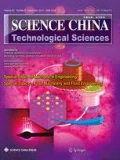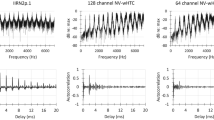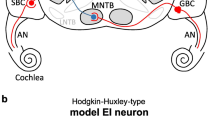Abstract
In studies of auditory perception, a dichotomy between envelope and temporal fine structure (TFS) has been emphasized. It has been shown that frequency-following responses (FFRs) in the rat inferior colliculus can be divided into the envelope component (FFREnv) and the temporal fine structure component (FFRTFS). However, the existing FFR models cannot successfully separate FFREnv and FFRTFS. This study was to develop a new FFR model to effectively distinguish FFREnv from FFRTFS by both combining the advantages of the two existing FFR models and simultaneously adding cellular properties of inferior colliculus neurons. To evaluate the validity of the present model, correlations between simulated FFRs and experimental data from the rat inferior colliculus were calculated. Different model parameters were tested, FFRs were calculated, and the parameters with highest prediction were chosen to establish an ideal FFR model. The results indicate that the new FFR model can provide reliable predictions for experimentally obtained FFREnv and FFRTFS.
Similar content being viewed by others
References
Moore B C J. The role of temporal fine structure processing in pitch perception, masking, and speech perception for normal-hearing and hearing-impaired people. J Assoc Res Oto, 2008, 9: 399–406
Rosen S. Temporal information in speech: Acoustic, auditory and linguistic aspects. Philos Trans R Soc B-Biol Sci, 1992, 336: 367–373
Smith Z M, Delgutte B, Oxenham A J. Chimaeric sounds reveal dichotomies in auditory perception. Nature, 2002, 416: 87–90
Xu L, Pfingst B E. Relative importance of temporal envelope and fine structure in lexical-tone perception (L). J Acoust Soc Am, 2003, 114: 3024–3027
Heinz M G, Swaminathan J. Quantifying envelope and fine-structure coding in auditory nerve responses to chimaeric speech. J Assoc Res Oto, 2009, 10: 407–423
Hopkins K, Moore B C J. The effects of age and cochlear hearing loss on temporal fine structure sensitivity, frequency selectivity, and speech reception in noise. J Acoust Soc Am, 2011, 130: 334–349
Strelcyk O, Dau T. Relations between frequency selectivity, temporal fine-structure processing, and speech reception in impaired hearing. J Acoust Soc Am, 2009, 125: 3328–3345
Johnson D H. The relationship between spike rate and synchrony in responses of auditory-nerve fibers to single tones. J Acoust Soc Am, 1980, 68: 1115–1122
Joris P X, Yin T C T. Responses to amplitude-modulated tones in the auditory nerve of the cat. J Acoust Soc Am, 1992, 91: 215–232
Young E D, Sachs M B. Representation of steady-state vowels in the temporal aspects of the discharge patterns of populations of auditorynerve fibers. J Acoust Soc Am, 1979, 66: 1381–1403
Kraus N, Nicol T. Brainstem origins for cortical ‘what’ and ‘where’ pathways in the auditory system. Trends Neurosci, 2005, 28: 176–181
Chandrasekaran B, Kraus N. The scalp-recorded brainstem response to speech: Neural origins and plasticity. Psychophysiology, 2010, 47: 236–246
Du Y, Ma T F, Wang Q, et al. Two crossed axonal projections contribute to binaural unmasking of frequency-following responses in rat inferior colliculus. Eur J Neurosci, 2009, 30: 1779–1789
Du Y, Kong L Z, Wang Q, et al. Auditory frequency-following response: A neurophysiological measure for studying the “cocktailparty problem”. Neurosci Biobehav Rev, 2011, 35: 2046–2057
Du Y, Wang Q, Zhang Y, et al. Perceived target-masker separation unmasks responses of lateral amygdala to the emotionally conditioned target sounds in awake rats. Neuroscience, 2012, 225: 249–257
Marsh J T, Worden F G. Some factors modulating neural activities in peripheral auditory centers. Brain Res, 1969, 12: 99–111
Moushegian G, Rupert A L, Stillman R D. Scalp-recorded early responses in man to frequencies in the speech range. Electroencephal Clin Neurophysiol, 1973, 35: 665–667
Ping J L, Li N X, Galbraith G C, et al. Auditory frequency-following responses in rat ipsilateral inferior colliculus. NeuroReport, 2008, 19: 1377–1380
Weinberger N M, Kitzes L M, Goodman D A. Some characteristics of the ‘auditory neurophonic’. Experientia, 1970, 26: 46–48
Worden F G, Marsh J T. Frequency-following (microphonic-like) neural responses evoked by sound. Electroencephal Clin Neurophysiol, 1968, 25: 42–52
Galbraith G C. Two-channel brain-stem frequency-following responses to pure tone and missing fundamental stimuli. Electroencephal Clin Neurophysiol, 1994, 92: 321–330
Krishnan A. Human frequency-following responses: Representation of steady-state synthetic vowels. Hear Res, 2002, 166: 192–201
Krishnan A, Gandour J T, Bidelman G M, et al. Experience-dependent neural representation of dynamic pitch in the brainstem. NeuroReport, 2009, 20: 408–413
Russo N, Nicol T, Musacchia G, et al. Brainstem responses to speech syllables. Clin Neurophysiol, 2004, 115: 2021–2030
Wang Q, Li L. Auditory midbrain representation of a break in interaural correlation. J Neurophysiol, 2015, 114: 2258–2264
Aiken S J, Picton T W. Envelope following responses to natural vowels. Audiol Neurotol, 2006, 11: 213–232
Dolphin W F, Mountain D C. The envelope following response: Scalp potentials elicited in the Mongolian gerbil using sinusoidally AM acoustic signals. Hear Res, 1992, 58: 70–78
Hall J W. Auditory brainstem frequency following responses to waveform envelope periodicity. Science, 1979, 205: 1297–1299
Shinn-Cunningham B, Ruggles D R, Bharadwaj H. How early aging and environment interact in everyday listening: From brainstem to behavior through modeling. In: Moore B, Patterson R, Winter I, et al., eds. Basic Aspects of Hearing. Advances in Experimental Medicine and Biology, vol 787. New York: Springer, 2013
Supin A Y, Popov V V. Envelope-following response and modulation transfer function in the dolphin’s auditory system. Hear Res, 1995, 92: 38–46
Zhu L, Bharadwaj H, Xia J, et al. A comparison of spectral magnitude and phase-locking value analyses of the frequency-following response to complex tones. J Acoust Soc Am, 2013, 134: 384–395
Bidelman G M. Multichannel recordings of the human brainstem frequency-following response: Scalp topography, source generators, and distinctions from the transient ABR. Hearing Res, 2015, 323: 68–80
White-Schwoch T, Nicol T, Warrier C M, et al. Individual differences in human auditory processing: Insights from single-trial auditory midbrain activity in an animal model. Cereb Cortex, 2016
Dau T. The importance of cochlear processing for the formation of auditory brainstem and frequency following responses. J Acoust Soc Am, 2003, 113: 936–950
Heinz M G, Colburn H S, Carney L H. Evaluating auditory performance limits: I. one-parameter discrimination using a computational model for the auditory nerve. Neural Comput, 2001, 13: 2273–2316
Kuokkanen P T, Wagner H, Ashida G, et al. On the origin of the extracellular field potential in the nucleus laminaris of the barn owl (Tyto alba). J Neurophysiol, 2010, 104: 2274–2290
Langner G, Schreiner C E, Biebel U W. Functional implications of frequency and periodicity coding in auditory midbrain. In: Palmer A R, Rees A, Summerfield A Q, et al., eds. Psychophysical and Physiological Advances in Hearing. London: Whurr Publ. Ltd., 1998. 277–285
Carney L H, Li T, McDonough J M. Speech coding in the brain: Representation of vowel formants by midbrain neurons tuned to sound fluctuations. eNeuro, 2015, 2
Paxinos G, Watson C, Carrive P, et al. Chemoarchitectonic Atlas of the Rat Brain. Atlanta: Elsevier, 2009
Longtin A, Middleton J W, Cieniak J, et al. Neural dynamics of envelope coding. Math Biosci, 2008, 214: 87–99
Zilany M S A, Bruce I C, Carney L H. Updated parameters and expanded simulation options for a model of the auditory periphery. J Acoust Soc Am, 2014, 135: 283–286
Jackson. The SGfast Mex Function. https://www.urmc.rochester.edu/MediaLibraries/URMCMedia/labs/carney-lab/documents/articles/Jackson-SGfast-2003.pdf, 2003
Goldstein Jr. M H, Kiang N Y S. Synchrony of neural activity in electric responses evoked by transient acoustic stimuli. J Acoust Soc Am, 1958, 30: 107–114
Dau T, Wegner O, Mellert V, et al. Auditory brainstem responses with optimized chirp signals compensating basilar-membrane dispersion. J Acoustical Soc Am, 2000, 107: 1530–1540
Gold C, Henze D A, Koch C, et al. On the origin of the extracellular action potential waveform: a modeling study. J Neurophysiol, 2006, 95: 3113–3128
Author information
Authors and Affiliations
Corresponding author
Rights and permissions
About this article
Cite this article
Wang, Q., Li, L. Modelling envelope and temporal fine structure components of frequency-following responses in rat inferior colliculus. Sci. China Technol. Sci. 60, 966–973 (2017). https://doi.org/10.1007/s11431-016-9044-5
Received:
Accepted:
Published:
Issue Date:
DOI: https://doi.org/10.1007/s11431-016-9044-5




